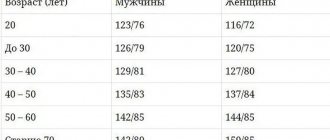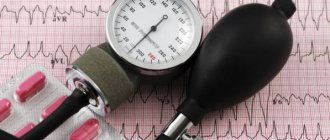Thanks to the continuous operation of a small pump located in our chest, the entire human circulatory system is constantly under pressure. With each heartbeat, a new portion of blood enters it; for the average person, its volume is 70 ml. This blood flows through the arteries to the limbs and vital organs, in order to further supply them with oxygen and nutrients through smaller vessels and capillaries. The pressure in different vessels is not the same. Often, to obtain a more complete diagnostic picture, doctors measure the pressure in the legs, the normal values of which are as important as the indicators of the brachial artery.
Why are pressure measurements taken in the leg area?
Blood pressure readings are taken on the legs for diagnostic purposes. If the doctor suspects that the patient has a narrowing of the vessels of the lower extremities, the patient undergoes such a study. Measuring blood pressure in the legs is considered a fairly effective method because it immediately reflects changes in the patient's blood flow. In addition, the ratio of blood pressure readings in the legs and arms is calculated - the ankle-brachial index. The index is used to assess the severity of arterial damage in the legs. In addition, by calculating the index value, the doctor can monitor the development of detected arterial disease.
Getting Accurate Results
To obtain correct results, the measurement procedure is repeated several times (at least three), after which the indicators are calculated as the arithmetic mean. Blood pressure is checked on both limbs and compared with readings on the arms.
Physical activity may interfere with obtaining correct results.
The following factors may affect obtaining correct results if they occurred shortly before the pressure measurement:
- alcohol;
- smoking;
- tonic drinks;
- physical exercise;
- eating;
- medications that affect blood pressure.
To obtain a result suitable for diagnostic purposes, all specified requirements must be met.
How to measure blood pressure in the lower extremities?
Methodology of the procedure
It is difficult to take readings on your feet on your own, so it is recommended to seek help from a medical institution.
To obtain data, you will need an electronic tonometer with a wide cuff (7-7.5 cm). The patient will be asked to lie down on the couch. The legs are straightened and positioned at the same level as the heart. Arms and legs should not be lifted up or moved, as this may distort the results. The person is given 5-10 minutes to calm down and relax before the procedure.
The cuff is placed on the ankle 2-3 centimeters from the back of the foot. There is no need to overtighten the cuff; there should be enough space between it and the skin for your finger. Air tubes are placed over the artery in which the pressure is measured. Next, the pulse is felt in the posterior tibial artery - below the bone on the inside of the ankle. After turning on the tonometer, it is necessary to inject air into the cuff and continue inflation until the pulsation disappears at the above point. Air is admitted another 20 mmHg. Art. and then gradually descends. It is necessary to release 2 mmHg. Art. air per second. The tonometer screen will show the recorded readings. You need to measure blood pressure in this way twice or thrice, and then calculate the arithmetic mean from the obtained numbers. On the second leg, blood pressure must be measured in the same way.
How to get an accurate result?
In order for the research results to be reliable, 1.5-2 hours before the procedure it is prohibited:
- eat;
- smoke;
- drink alcoholic and tonic drinks;
- take medications that act on alpha and beta adrenergic receptors;
- play sports.
Return to contents
Characteristics of blood pressure
Blood pressure is closely related to the heart muscle, and the elasticity of blood vessels depends on it. Organs in the body are supplied with oxygen, as well as important components, due to pressure in the blood vessels. After the muscle has contracted, it is necessary to determine the upper pressure.
Before each pumping of blood after compression, a temporary relaxation of the heart is observed. Blood pressure levels decrease. The lower pressure is determined when the pressure reaches its maximum value. There are certain numbers for measuring blood pressure, they are called millimeters of mercury. The main thing is the top indicators.
Norm
Throughout the patient's life, changes in blood pressure limits are observed. This is affected by past as well as congenital diseases. In an adult patient, the normal average is 120/80 mmHg. Art. In men, as well as in women, pressure numbers increase with age.
Classic measurement
When we talk about blood pressure readings, we, by default, mean the values obtained from the brachial artery. In fact, you can measure pressure in your legs and arms. Modern methods make it possible to obtain data on blood pressure directly in the aorta or other individual vessel.
The brachial artery was not chosen for quick diagnosis by chance:
- it is located quite close to the heart muscle and, therefore, gives an idea of the work of the whole organism as a whole;
- Taking measurements on your hand is accessible and convenient.
Most people know that the determination is carried out using a special device - a tonometer.
With this method, the tonometer readings of 120/80 mmHg are taken as the average normal level. These figures, taking into account minor individual deviations, are relevant for a young adult. With age, normal blood pressure increases. So, for example, for a seventy-year-old man, the pressure is 140/90 mmHg. is normal, although the same indicators are unacceptable for a twenty-five year old. In women at a young age, the norm is 5-8 units lower than that of men; over the years, it is ahead of the indicators of the stronger sex. After 70 years, blood pressure is 150/90 mmHg. for the average woman is considered to correspond to the standard.
Reasons for measuring pressure in the leg area?
Typically, measuring blood pressure in the lower extremities is used for therapeutic purposes. This study is usually carried out by specialists if they suspect narrowing of the blood vessels in the legs. One of the best diagnostic methods includes measuring blood pressure in the legs, this is due to changes in blood flow.
After the measurement, the ratio of the obtained lower and upper indicators is calculated - this is called the ankle-brachial index. It helps assess how damaged the arteries in the legs are. The calculation helps the doctor identify the disease and control its development.
How to measure blood pressure in the lower extremities?
To measure the pressure in your legs, it is recommended to use the following method:
- The patient needs to lie down and straighten his lower limbs. They should be at the same level as the heart. Suspended limbs should be avoided. The patient needs to relax; it will take 5-10 minutes to adapt to the measurement conditions. Before the measurement, approximately 1.5-2 hours before the measurement, you must stop eating food, alcohol, as well as smoking and tonic drinks, and avoid taking medications, especially eye drops. Before conducting the study, you should avoid physical activity or wait half an hour.
- The patient should breathe calmly, since deep breathing results are inaccurate. The cuff of the electronic tonometer should be placed on the ankle; it should be 2-3 cm above the back of the foot. Install the cuff in such a way that there is a finger-sized space between the skin of the limb and the device. Install air tubes over the artery where patency is checked.
- Below and behind the location of the bone you need to find the pulse. It is usually located on the inside of the ankle, where the tibial artery passes through.
- When the device is turned on, air must be pumped into the cuff; this is done if there is no automatic air supply. Air is supplied until the pulse stops giving indicators plus another 20 mmHg. Art. You can’t squeeze too hard, because pain will appear in the foot.
- The air must be released gradually, no more than 2 mmHg. Art. in one second. After this, the results will appear on the screen of the measuring device. The first number determines the state of systolic pressure, and the second determines diastolic pressure. The automatic and semi-automatic devices have special sound signals; in addition, hints appear on the screen and help you navigate during the measurement.
- Once is not enough, so it is better to carry out the procedure 2-3 times. The result obtained is determined by the arithmetic mean of all indicators. The same procedure must be carried out on the second lower limb.
Using an electronic tonometer
The procedure is carried out using an electronic tonometer, which has a wide cuff, approximately 7-7.5 cm. The patient lies on a flat surface, set the lower limbs in a straight position so that they are at the same level as the heart. It is forbidden to move your limbs, pointing them up or down, as this will cause the results to be inaccurate. Within 5-10 minutes the patient relaxes and calms down, after which the technique is carried out.
Place a tonometer cuff on the ankle, keeping no more than 2-3 cm from the dorsum of the foot. The cuff should not be overtightened; a finger should be placed in the remaining space. Place air tubes above the vein where the pressure is measured. Feel the pulse in the tibial artery, then turn on the measuring device and let air into the cuff. Bleed air until the pulsation disappears.
Blow in a little air again, about 20 mmHg. Art. and slowly let air through. 2 mmHg should come out per second. Art. the recorded indicators will appear on the screen of the measuring device. It is recommended to check blood pressure several times, then obtain the arithmetic average from the results obtained. Then move to the second lower limb and measure the pressure according to the previous scheme.
Methods for measuring blood pressure
Blood pressure is measured in millimeters of mercury – abbreviated mmHg. Art. The first (large) number indicates the force of blood pressure on the walls of blood vessels at the moment of heart contraction and is called systolic.
The second (smaller) number records the blood pressure in the vessels at the moment of relaxation of the heart muscle, that is, diastole and is called diastolic.
The optimal level of blood pressure for a person is considered to be 120/80 mmHg. Art.
To determine blood pressure levels in modern medical practice, mechanical or electronic tonometers are used. The measurement mechanism is based on listening with a stethoscope or phonendoscope to arterial tones, which are determined below the site of compression of the vessel.
Measuring blood pressure with a mechanical tonometer
The Russian surgeon N. S. Korotkov was the first to propose and begin to use a mechanical tonometer to determine the level of pressure in a person in 1905. The Korotkov method involves using a very simple tonometer to measure blood pressure, which consists of several parts:
- pressure gauge, membrane or mercury;
- rubber cuff (hollow inside);
- rubber bulb for pumping air into the cuff;
- stethoscope or phonendoscope.
The Korotkoff technique for measuring blood pressure is an auscultatory method, that is, measurement is carried out by listening to arterial sounds in the peripheral parts of the arteries below the place that is compressed by the cuff.
A cuff is attached to the shoulder, and air is pumped into it using a bulb until the brachial artery is completely compressed and blood flow in it is stopped. At this time, no tones are heard. Then the air is slowly released from the cuff and the appearance of tones is listened to using a stethoscope or phonendoscope.
A cuff pressure of 20-30 mm Hg is considered sufficient. Art. exceeding blood pressure, at which listening to systolic sounds stops (when the pressure gauge needle moves up). In practice, this rule is rarely observed. In most cases, the cuff is inflated to 160-180 mmHg. Art., depending on the expected performance.
With a gradual decrease in pressure in the cuff, the blood pressure in the vessel overcomes the resistance, and blood flow through the artery resumes, this is accompanied by a sound (tone). The appearance of the first tone corresponds to the maximum (systolic) blood pressure in the vessels at the moment of contraction of the heart muscle. This indicator is always recorded first. Then the tones continue to be heard for some time; when comparing the pressure in the cuff and artery, the tones are no longer detectable by ear. The digital value of this moment on the tonometer corresponds to diastolic pressure, that is, relaxation of the heart muscle (diastole). The diastolic value is recorded after the systolic value.
The method of measuring pressure with a mechanical tonometer is not complicated, but without special training errors may occur, therefore it is more often used in professional medicine.
Measuring blood pressure with an electronic tonometer
The oscillometric method is used in automatic and semi-automatic tonometers.
The devices are equipped with a cuff, the inner surface of which is a sensor, it plays the role of a stethoscope. Its function is to record the amount of change in the limb during a pulse impulse, invisible to the eye. Then the information is transmitted via cable to the device, where it undergoes complex processing in an analog-to-digital converter using a program for calculating indicators. As a result, the analysis results are converted into pressure numbers that appear on the display screen.
Some models of blood pressure monitors can detect premature or missed heartbeats and record the arrhythmia on the display. The screen also displays your heart rate.
Semi-automatic blood pressure monitors are suitable for home use, which are equipped with a rubber bulb for manually pumping air into the cuff and fully automatic electronic devices; air is pumped into their cuff automatically by an electric pump after pressing one button.
Is there a difference between the indicators on the arms and legs?
In the main vessel near the thigh, diastolic pressure is the same as blood pressure in the brachial region. When measuring systolic pressure, a deviation of 10-20 mmHg is noted. Art. – this deviation is considered a significant difference. Unlike the upper extremities, high pressure in the legs is normal. This phenomenon is due to the presence of a wide thigh circumference, which is smaller than the shoulder circumference. Judging by the level of indicators, if blood pressure goes beyond normal limits, you need to pay attention and seek help from a specialist.
Why is the pressure different?
Normally, the pressure in the legs is greater than in the arms. The main reason for this is that the lower extremities require more blood to supply blood than the upper extremities. This is simply explained - the circumference of the thigh is greater than the circumference of the shoulder. The difference defined as critical is 20 mmHg. Doctors came to this figure as a result of many years of research and it is of an average statistical nature. When taking measurements and subsequent diagnostics, the doctor takes into account the individual characteristics of the patient’s body, his complexion, the presence of concomitant diseases and possible errors in measuring pressure.
Do you still think that it is difficult to cure hypertension?
Deviation of normal indicators is observed in 20-30% of the adult population. As age increases, the numbers increase, the disease progresses and high blood pressure is observed in 50-65% of the population.
High blood pressure is accompanied by consequences that are the result of irreversible damage to organs. With a prolonged illness, movement coordination is impaired, the lower and upper limbs weaken, vision decreases, a person experiences loss of memory and intelligence, and stroke often occurs.
But all this can be prevented if you consult a doctor in time and start treatment. Hypertension, like other diseases, is treatable. There are many medications that can eliminate the disease.
Simple and cheap method
For a hundred years, doctors have been using a popular diagnostic method: measuring blood pressure in the legs. Pathological changes in the cardiovascular system can be determined using modern hardware methods, but not all medical institutions can afford to purchase hardware diagnostics.
There is a reliable method that can be used by all patients, it helps to conduct further research on the disease. In case of emergency measures and urgent indications, it is necessary to measure blood pressure in the legs. This method is practically no different from modern methods and gives excellent results.
Blood pressure in the lower extremities
Control of blood pressure is necessary for people with cardiovascular problems. Not many people know that you can measure blood pressure in your legs; there are certain rules for this. It is very useful to compare the results of measurements on the upper and lower extremities in order to have a complete picture of disorders or their absence in the body. Often this helps to avoid serious consequences and death of a person.
What is the norm?
Blood pressure is not a constant value. In addition to the fact that it changes during the work cycle of the heart muscle (it is these indicators that we record with a tonometer), age-related changes also occur.
Blood pressure is a strict factor in the functioning of the human cardiovascular system, so it is extremely important to keep it within normal limits
Blood pressure can rise and fall throughout the day depending on:
- physical and psycho-emotional stress;
- weather conditions;
- ingestion of food or drinks that affect vascular patency and cardiac muscle activity;
- other factors.
There are a lot of such factors. Strictly speaking, each person has his own individual level of pressure at which he feels comfortable. This value is often called working pressure, and it is the norm for a particular patient. However, the generalized data allows us to talk about an averaged parameter, which is accepted as normal.
Normal pressure in the legs
Blood pressure in the lower extremities is considered normal if it is slightly higher than in the upper extremities, but does not exceed 19-21 mm Hg. Art. Normal systolic pressure in the legs should be 140-150. With reduced values, we can talk about a narrowing of the main arteries and a danger to the patient’s health. If the tonometer values are radically different, this is a reason to consult a doctor.
Narrowing of the aortic artery threatens its rupture and death for a person.
The result is not normal
After receiving data on blood pressure readings in the patient’s extremities, the doctor can conduct a preliminary diagnosis of possible problems in the circulatory system.
- If the pressure on the legs is greater than on the arms, and the difference does not exceed 20 mmHg, then this is one of the normal options.
- When the blood pressure level in the arm is significantly lower than in the lower limb, this may indicate a problem with the blood supply to the upper limb. Such an anomaly can be caused, for example, by subclavian steal syndrome, which occurs as a result of the formation of an atherosclerotic plaque.
Knowing the ABI is very important as it is useful as an indicator of peripheral arterial disease (PAD)
- If the pressure in the legs is less than in the arms (the difference is more than 25-30%), then there is every reason to suspect coarctation of the aorta in the patient. With this disease, the lumen of this vessel narrows segmentally. The development of pathology leads to aortic rupture and death.
In the initial diagnosis, systolic pressure indicators are usually taken into account, since diastolic pressure rarely differs.
Difference from blood pressure on the hands
Blood pressure measurements in the arms and legs are carried out to establish the true picture of circulatory failure in the body. High pressure in the lower extremities indicates serious disturbances in blood flow and a decrease in the lumen of the aorta, and low blood pressure in the upper extremities indicates the same. You should consult a doctor if the following symptoms are associated with such tonometer data:
The addition of migraines to this symptom is a reason for a person to consult a doctor.
- nausea and vomiting;
- dizziness and fainting;
- general weakness, feeling of fatigue;
- migraine.
Return to contents
What influences the difference in indicators?
There are several important points that can affect blood pressure levels in different arms. Among them:
- Technique used. Automatic blood pressure monitors are considered more convenient because they do not require any skills on the part of the patient or, more precisely, the user. However, accuracy suffers.
Mechanical devices are more accurate, but their use requires some skill.
Thus, a banal hardware error is possible. The error in cheap automatic devices is within 5-10 mmHg.
- Time of the study. The most accurate results are in the morning. As we move towards evening, a person is influenced by many factors of various kinds. These include stress, nutritional factors and physical overload.
Therefore, for the accuracy of the result, it is recommended to measure three times a day: in the morning before the first meal, before 14.00 before lunch and in the evening, right before bed, when the body is preparing to rest.
If the numbers differ significantly within a significant range all three times, you can assume that something is wrong.
- Compliance with measurement rules. Doctors are familiar with them, but not all of them. Depends on the competence of a particular specialist.
When measuring blood pressure, you need to sit up straight, do not tighten the cuff too tightly, do not lean back in your chair, do not strain, and place your hand at the level of your heart in order to cause a false increase in blood pressure.
Only if all recommendations are followed, the result will be accurate. Otherwise, you need to wait 10-15 minutes and repeat the procedure.
- Different hands have different pressures - this is an axiom, and you should not be afraid of such a phenomenon. Typically, the blood pressure level is higher on the leading limb. A deviation of 11 mmHg or more is considered pathological.
- Fatigue, overwork. As a rule, with significant negative effects on the body, the blood pressure level will be different in different arms. A tired patient is not a good example. You need to measure your blood pressure while you are awake.
It is necessary to evaluate all technical factors in a comprehensive manner.
A competent doctor will do this at the initial appointment, and to eliminate stupid mistakes of this kind, he will offer the patient temporary inpatient observation.
How to measure pressure in your legs?
To get reliable results, 2 hours before measurements it is not recommended to drink alcoholic beverages, smoke, eat, exercise, or use medications against hypertension. There are two ways to measure blood pressure in the lower extremities. The patient will not be able to do this himself, because he must lie down during the manipulation.
On the ankle
- The tonometer cuff is placed on the ankle, 3 centimeters from the beginning of the foot.
- Feel for the pulse and pump air until vibrations are heard.
- By releasing air little by little, the readings are recorded.
Return to contents
On the right or left thigh
To measure blood pressure at the thigh, the patient needs to roll over onto his stomach. To do this, you need a cuff of sufficient length; it is placed slightly above the knee. The procedure is carried out as at the first appointment. You can measure the pressure in your legs with a hand-held tonometer with a phonendoscope or an electronic device. To obtain reliable results, blood pressure is measured several times a day.
How to measure blood pressure correctly?
If you have hypertension or hypotension, you need to measure your blood pressure before taking any medication. To carry out this procedure correctly and get an error-free result, you should follow simple steps. The measurement on the hands goes like this:
- 1 hour before measuring blood pressure, drinking alcohol, coffee and other tonic and energy drinks is not recommended. It is necessary to avoid smoking to avoid vasoconstriction, and not to perform physical work.
- In 5-10 minutes. Before the study, you need to calm down and relax. Otherwise, the data may be inaccurate.
- Before diagnosis, it is advisable to visit the restroom to empty the bladder to relieve the urinary system.
- It is better if the upper limbs and legs are free and not crossed during the procedure.
- To accurately measure, sit on a chair, straighten your back, place your hand on the table, palm up.
- The arm should be bent in front of the heart.
Measurement on feet
There are two ways:
When measuring blood pressure in this way, you can get higher values than on the forearm.
- On the hip. The patient should lie on his stomach, then he needs to fix the cuff, which should be 3 cm up from the kneecap. It should be noted that diagnostic data on the legs will be greater than on the arms. This is due to the fact that the size is large in relation to the forearm. But if the numbers on the legs are lower than the numbers on the arms, an ultrasound is required to rule out vascular pathology.
- On the ankle. The person lies on his back, and a device must be placed on his ankle, which should be 3 cm from the beginning of the foot. Then the process is carried out as in the hands. Indicators on the legs will be higher than on the upper extremities: upper blood pressure by approximately 35 mm Hg. Art., lower - by 15 mm Hg. Art. With systolic readings equal to 140-150 mm Hg. Art., this is considered the norm. But if the numbers turn out to be higher, then you should consult a doctor.











